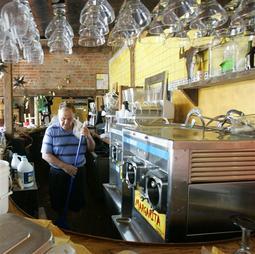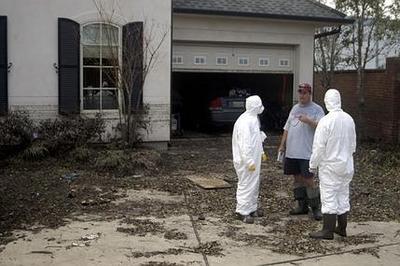
Gerald Boulmay, general manager of Bandito's, a Mexican restaurant near the convention center district of New Orleans, sweeps bleach water on the floor behind the bar on Tuesday, Sept. 13, 2005. He and so many other businesses are hustling to get back open, now two weeks after Hurricane Katrina struck the city.
From the New York Times:
NEW ORLEANS, Sept. 13 - An upbeat Mayor C. Ray Nagin announced on Tuesday that he hoped to reopen four neighborhoods, including the city's central business district and the French Quarter, to residents and business owners in the next few days.
"I have started to get into the mode of how do we reopen the city and how do we move it to the next level," Mr. Nagin said, appearing relaxed, even cracking jokes, while speaking to reporters in the French Quarter.
At the same time, he conceded that the city's financial problems were enormous. "The city is out of cash," he said. "We do not have the cash to make the payroll coming up."
Mr. Nagin said that city officials were trying hard to secure a line of credit. Many contractors who are helping the city clean up are working under the assumption that the city will get money to pay them.
The final go-ahead to reopen the city's central business district and the French Quarter, along with two residential neighborhoods - Algiers and Uptown - depends on an environmental report he said he expected to receive later in the day. He had been briefed on the report, on the quality of the air and water, he said, and things "looked good."
The four areas are now dry.
As for what residents will return to, Mr. Nagin cited progress on a number of fronts. City officials were working to get two hospitals - Touro Infirmary and Children's Hospital - running soon. The water is safe to drink in Algiers, and Mr. Nagin said he hoped drinkable water would be restored to the three other neighborhoods by the end of this week.
...264,000 of the 1.1 million customers in Louisiana and Mississippi who lost power after Hurricane Katrina were still without it. Most of those, Mr. Packer said, are in the metropolitan area.
He said he expected electricity would be restored to the central business district and the French Quarter in 10 days to two weeks. With more than 40 pumping stations online, water was now being drained at a significant rate from the city, Mr. Nagin said.
Teams will soon finish a door-to-door search of every home in the city, said Maj. Gen. William Caldwell, commander of the 82nd Airborne Division of the Army.
General Caldwell estimated that 3,000 people remained, in defiance of a mandatory evacuation order.
As for the long term, the mayor said he would establish a commission to plan major aspects of the city's restoration. "I'm tired of hearing these helicopters," he said. "I want to hear some jazz."
Amazing!
In just over two weeks after Hurricane Katrina made landfall, New Orleans is showing signs of rebirth. Progress is being made.
At a news conference on Monday, September, 5, Deputy Police Chief Warren Riley painted a very different picture. He said there was no reason for people to stay in New Orleans.
From CNN:
Deputy Police Chief Warren Riley said thousands of people were still in the city a week after Hurricane Katrina ripped across southeast Louisiana.
"We are working with them to try to convince them that there is no reason -- no jobs, no food -- no reason for them to stay," Riley said.
"We advise people that this city has been destroyed. It has been completely destroyed."
Thankfully, New Orleans was not "completely destroyed."
In fact, I'm shocked that areas of the city are coming back to life so soon.
I'm aware that the progress is minimal. I certainly don't mean to diminish the incredible suffering endured by the tens of thousands of people that have been displaced and have lost everything they owned.
Nevertheless, Mayor Nagin says parts of this "destroyed" city are already set to reopen.
According to USA Today, floodwaters still cover 40% of the city.
The U.S. Army Corps of Engineers says it hopes to pump all the floodwater out of New Orleans by Oct. 8.
...Meanwhile, the water that has accumulated on New Orleans' streets poses health risks to recovery workers and residents. Besides leaves and dirt, it now carries backed-up sewage, feces and bacteria from decomposing bodies, as well as toxic chemicals from small businesses such as dry cleaners whose storage tanks flooded.
...Even when it dries, the polluted stew will coat streets, parks and yards with a film of toxic chemicals and sewage. Cleansing the land of contamination could take months, maybe years.
"Are the schoolyards and people's yards going to be so contaminated that we're going to have to scrape them up? That's the big unknown right now," Pardue says. "It's not a very rosy picture, I'm afraid."

Members of the Arkansas National Guard, wearing protective suits, check on residents in Metairie Club Estates Metairie, La., Tuesday, Sept. 13, 2005.
I see a disconnect here.
Which is it?
Is New Orleans a wasteland that needs to be bulldozed or will it be ready to accommodate a scaled-down celebration of Mardi Gras?
Pittsburgh's Post-Gazette reports:
Monday, with half the city still underwater, bodies yet to be found, and President Bush in town, Nagin took a minute in a radio interview to hype the 2006 Mardi Gras, which culminates on Fat Tuesday, Feb. 28.
"It's going to be awesome. We'll be letting it all hang out," he said.
I'm confused.
"Cleansing the land of contamination could take months, maybe years."
Just how contaminated are the streets of New Orleans?
Apparently, not too contaminated to stop Mardi Gras.
No comments:
Post a Comment